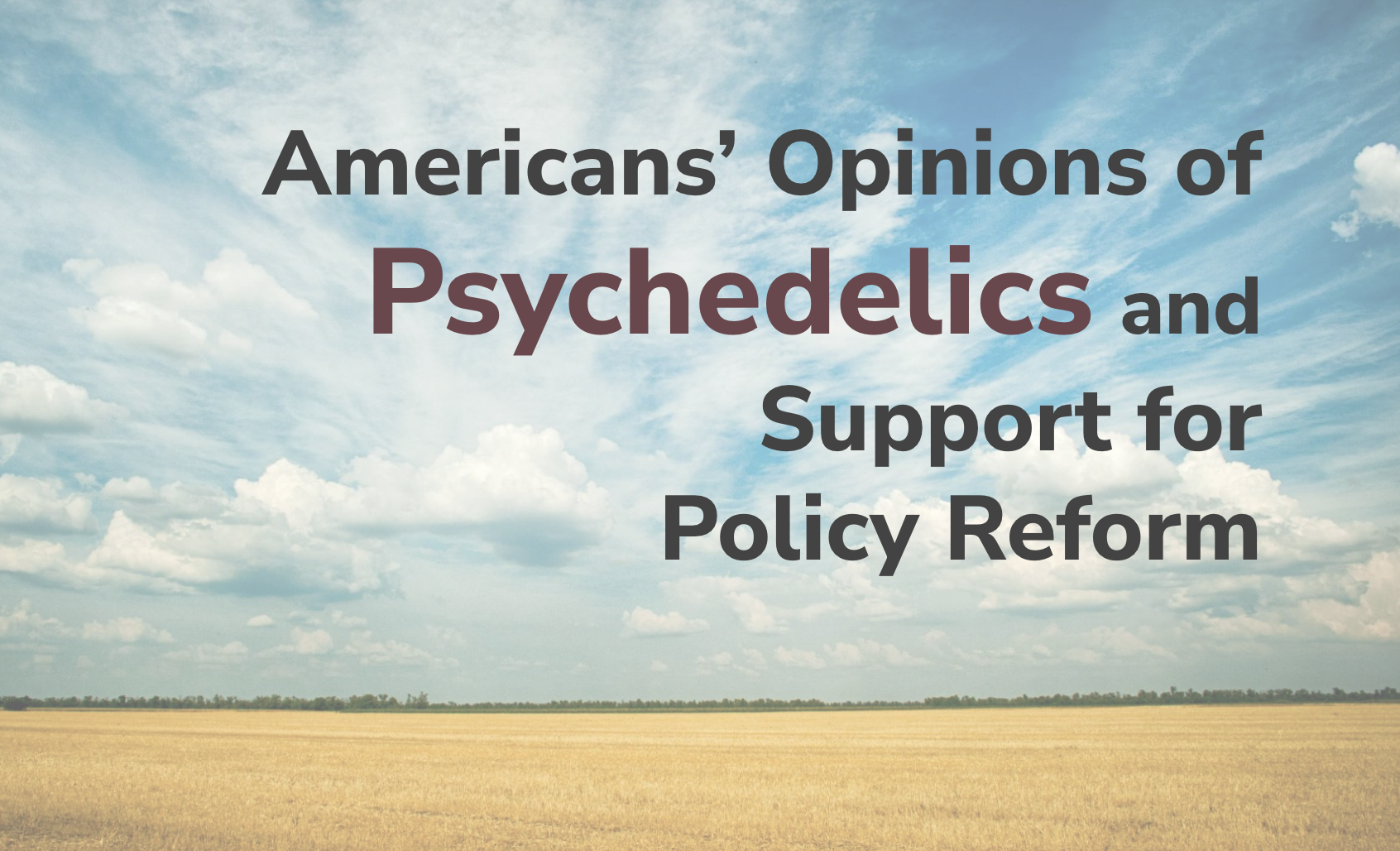Data & Strategy
FULL REPORT: Americans’ Opinions of Psychedelics and Support for Policy Reform
June 2025 | data
Here we provide free access to The XandY Poll’s 2025 findings on American public perception of psychedelics, as well as our new policy experiment that shows how variations in policy types affect support and opposition. The full report deck is available for download as a PDF, which includes an executive summary and key strategy takeaways.
What people think of when they hear the term “psychedelics."
March 2025 | data
Using open-ended response from The XandY Poll, we show the concepts that are most closely associated with the term “psychedelics” in the minds of American adults. These insights help us understand the prevalence of different harmful and helpful mental models on this topic.
Most Americans are unable to identify any specific benefits or risks of crypto.
January 2025 | data
This article summarizes data from The XandY Poll on the benefits and risks of crypto that Americans are aware of. The findings show that most people cannot identify any specific benefits or risks. This is often overlooked by experts, and it signals a need for clear, simple narratives about crypto.
Why we keep moving the goalposts on artificial intelligence.
December 2024 | data
From chatbots to driving apps to virtual assistants, many of our daily tools would have been considered “artificial intelligence” not long ago. But today, most people do not consider most of these things to be AI. Here we discuss why we keep moving the goalposts, and how this ever-shifting standard for AI is seen in our recent survey data.
FULL REPORT: How Americans View AI Tools
October 2024 | Data
Here we provide free access to The XandY Poll’s findings regarding American public opinion about AI tools. The full report deck is available for free download as a PDF, and contains an executive summary as well as a wide variety of data visualizations and strategic takeaways.
How can 1,000 people tell us what the whole nation thinks?
August 2024 | Strategy
How could the views of such a small group of survey participants reliably tell us about the beliefs of millions? In this article, we summarize how and why a well-conducted survey of 1,000 people can indeed provide a reliable snapshot of the opinions and behaviors of an entire country. The answers are found in some simple logic… and in a pot of soup.
FULL REPORT: How Americans Think About Psychedelics
August 2024 | data
Here we provide free access to The XandY Poll’s findings regarding American public opinion about psychedelics. The full report deck is available for download as a PDF, and it includes an executive summary and key strategy takeaways.
Most Americans overestimate the harms of psychedelics.
may 2024 | data
Although psychedelics such as LSD and psilocybin mushrooms are remarkably safe and non-addictive, many people still overestimate their harmfulness. In this article, we summarize findings from The XandY Poll that show Americans’ perceptions of the harmfulness of specific psychedelic substances and how they compare to perceived harmfulness of tobacco and alcohol.
Crypto has a trust problem.
April 2024 | data
The objective functional merits of any idea or innovation—including blockchain technologies—are not enough to guarantee successful adoption. Companies and organizations must directly engage with building a strong positive relationship with the public. In this article, we summarize findings from our recent national survey that show the extent to which Americans trust or distrust specific types of decision makers within the crypto industry.
How to communicate uncertainties without losing credibility.
March 2024 | strategy
Because some degree of uncertainty is unavoidable in almost everything, organizations are faced with a decision: how should we handle uncertainties when communicating with our stakeholders? In this article, we discuss our research showing the specific types of situations in which communicating uncertainty tends to have those negative effects, as well as the specific situations in which the effects instead tend to be positive.
Support for allowing MDMA treatment of PTSD far outnumbers opposition.
february 2024 | data
One of the most promising recent advances in mental health science is the use of MDMA to treat PTSD. However, public support or opposition can influence regulatory progress and general cultural perceptions. Here, we report findings from The XandY Poll on how much people support or oppose the idea of allowing MDMA to be used for treating PTSD.
Who is trusted (and who is not) for information about psychedelics?
January 2024 | Data
Because many people are still undecided on the topic of psychedelics, the new information they hear — and who they hear it from — will be very influential. Here, we report findings from The XandY Poll on how much people trust or distrust various information sources on psychedelics.
How should AI tools be used? Americans support some uses but not others.
December 2023 | Data
Recent advances in AI technology have produced a cornucopia of new abilities and use cases. While some uses are supported by most people, there are other uses that many people oppose. Here we summarize our recent findings from The XandY Poll that show which uses of AI tools are supported or opposed.
Three overlooked factors in communication strategy.
November 2023 | Strategy
In our research and consulting, we have consistently found that organizations tend to overlook three important factors when creating and evaluating their communication strategies: the Reach x Effect Tradeoff, the Immediate Effects Bias, and the Zero Resistance Fallacy. Here, we explain these three common dilemmas and pitfalls in communication strategy–while also highlighting solutions.
The 3 problems in climate communication and how to fix them.
October 2023 | Strategy
Despite good intentions, most people and organizations stumble into three counterproductive patterns when trying to communicate about climate change. We call these (1) Polar Bears, (2) Politics, and (3) Apocalypse. Here, we summarize the scientific research that shows why these typical patterns are so harmful. We also show how the data points to more effective strategies that are easily available.
How Americans think about renewable energy and why it matters for the energy transition.
September 2023 | data
The success of the energy transition depends on consumer demand and political support. But Americans’ opinions are quickly growing more divided and complex. Here, we explain the key takeaways from the most rigrorous scientific research on (1) how Americans think about renewables, (2) why they think that way and what influences them, and (3) how these things are changing over time.
How long does persuasion last?
August 2023 | data
When your audience is persuaded by your content (ads, sales pitch, etc.), how long does that persuasion last? Does it fade immediately or does it stick around for a long time? Here we summarize our series of scientific studies which test the durability of persuasion. We summarize which types of persuasive messages have effects that truly last over time, and which types of people are most likely to experience long-lasting change in their opinions and behaviors.
Durability: The missing piece in communication campaigns.
August 2023 | strategy
When strategists are developing persuasive communications, they often test them ahead of time (in RCTs, focus groups) to see how persuasive they really are. But one aspect is almost always overlooked: the durability of the effect. Will the positive sentiment stick or fade? Will increased purchase intentions remain long enough to translate to sales? Will people initially plan to vote for your candidate but then be easily swayed? We summarize the reasons why durability is a crucial component to optimize for when designing communication campaigns.
The most effective ways to persuade people to act sustainably.
July 2023 | strategy
We recently published one of the most world’s most comprehensive scientific studies on how to persuade people to make more sustainable decisions. Here you can read a summary of which strategies work best, which behaviors are most moveable, and how we can make strategic trade-offs when considering all moving pieces.



















